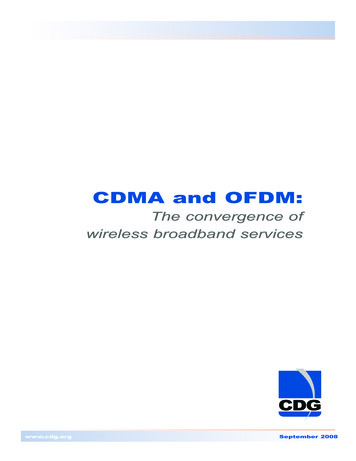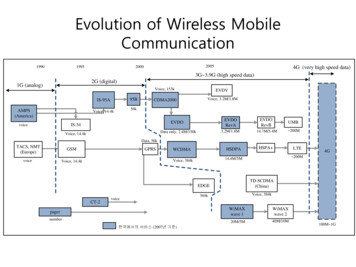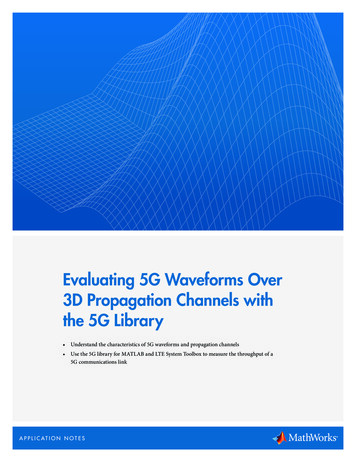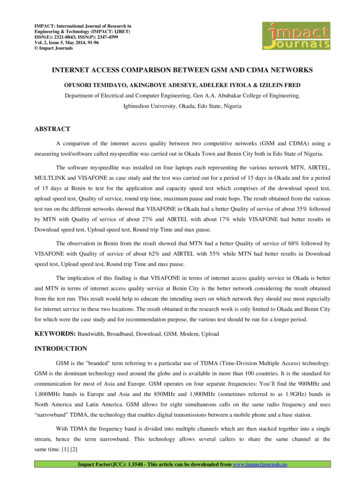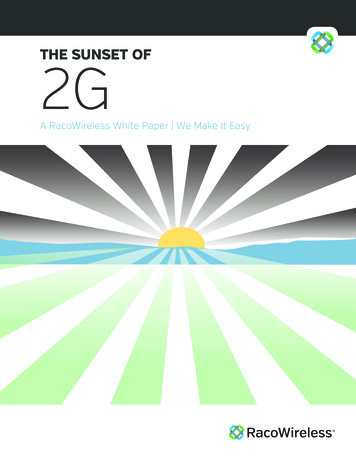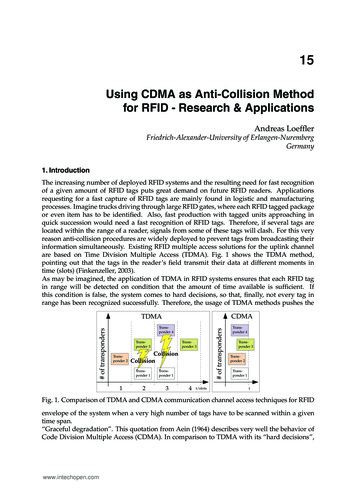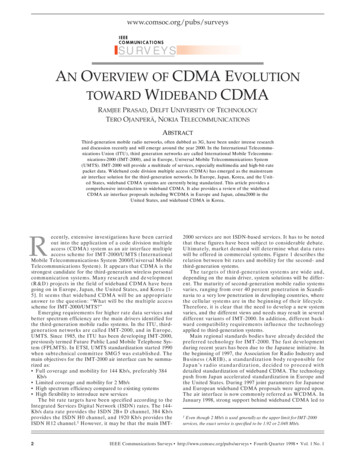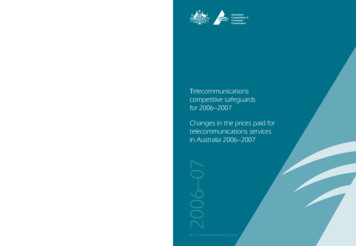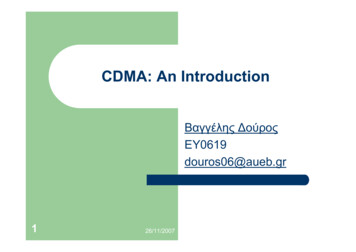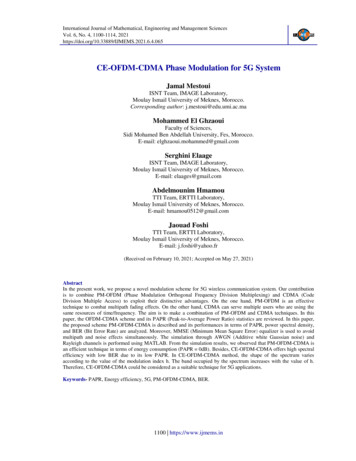
Transcription
International Journal of Mathematical, Engineering and Management SciencesVol. 6, No. 4, 1100-1114, -OFDM-CDMA Phase Modulation for 5G SystemJamal MestouiISNT Team, IMAGE Laboratory,Moulay Ismail University of Meknes, Morocco.Corresponding author: j.mestoui@edu.umi.ac.maMohammed El GhzaouiFaculty of Sciences,Sidi Mohamed Ben Abdellah University, Fes, Morocco.E-mail: elghzaoui.mohammed@gmail.comSerghini ElaageISNT Team, IMAGE Laboratory,Moulay Ismail University of Meknes, Morocco.E-mail: elaages@gmail.comAbdelmounim HmamouTTI Team, ERTTI Laboratory,Moulay Ismail University of Meknes, Morocco.E-mail: hmamou0512@gmail.comJaouad FoshiTTI Team, ERTTI Laboratory,Moulay Ismail University of Meknes, Morocco.E-mail: j.foshi@yahoo.fr(Received on February 10, 2021; Accepted on May 27, 2021)AbstractIn the present work, we propose a novel modulation scheme for 5G wireless communication system. Our contributionis to combine PM-OFDM (Phase Modulation Orthogonal Frequency Division Multiplexing) and CDMA (CodeDivision Multiple Access) to exploit their distinctive advantages. On the one hand, PM-OFDM is an effectivetechnique to combat multipath fading effects. On the other hand, CDMA can serve multiple users who are using thesame resources of time/frequency. The aim is to make a combination of PM-OFDM and CDMA techniques. In thispaper, the OFDM-CDMA scheme and its PAPR (Peak-to-Average Power Ratio) statistics are reviewed. In this paper,the proposed scheme PM-OFDM-CDMA is described and its performances in terms of PAPR, power spectral density,and BER (Bit Error Rate) are analyzed. Moreover, MMSE (Minimum Mean Square Error) equalizer is used to avoidmultipath and noise effects simultaneously. The simulation through AWGN (Additive white Gaussian noise) andRayleigh channels is performed using MATLAB. From the simulation results, we observed that PM-OFDM-CDMA isan efficient technique in terms of energy consumption (PAPR 0dB). Besides, CE-OFDM-CDMA offers high spectralefficiency with low BER due to its low PAPR. In CE-OFDM-CDMA method, the shape of the spectrum variesaccording to the value of the modulation index h. The band occupied by the spectrum increases with the value of h.Therefore, CE-OFDM-CDMA could be considered as a suitable technique for 5G applications.Keywords- PAPR, Energy efficiency, 5G, PM-OFDM-CDMA, BER.1100 https://www.ijmems.in
Mestoui et al.: CE-OFDM-CDMA Phase Modulation for 5G System1. IntroductionRecently, technology has made huge steps, especially in the field of the development of mobileelectronic devices. To support, the advanced requirements of high throughput. Future mobilecommunication systems must combine different modulation and multiple access techniques.OFDM is a basic multi-carrier technique in the implementation of wireless communicationnetworks. OFDM was a key solution in the development of the most important physical layerprotocols: Wi-Fi "IEEE 802.11", LTE "3GPP", and Wi-MAX "IEEE 802.16" (Ansar and Noor,2018). However, OFDM signals suffer from a high PAPR (Rajasekaran et al., 2019). The highPAPR associated with OFDM signal is caused by the power amplifier (PA) at the transmitter(Banelli, 2003). If any additional power is not injected in Input, OFDM suffers from spectralwidening which causes by the non-linear component of the transceiver (Singya et al., 2017). Thisproblem limits the performance of the OFDM system especially in the case of battery-poweredwireless systems. These problems can be solved by increasing the IBO (Raab et al., 2002). Manytechnics have been suggested to resolve this problem (Mohammady et al., 2019, 2020). However,the PAPR reduction technics proposed in the literature suffer from either complexity or high BER(El Ghzaoui et al., 2020). The phase modulator has the advantage of producing a modulatedsignal with the lowest possible PAPR (0 dB). In this case, the PA can be used efficiently in thetransmission chain based on the OFDM system. A zero PAPR allows the power amplifier to beused with maximum efficiency as well as increases the choice of the system as more signal poweris radiated into the channel. On the other hand, the generations of wireless networks implementedso far have employed CDMA as a multi-user technique. In CDMA, each user is assigned aspecific code for the duration of the call. For single-user technics, the capacity is restricted by thetime/frequency resources. In CDMA technique, the number of users is fixed by the properties ofthe utilized spreading codes. Therefore, CDMA has the ability to increase the capacity of awireless communication system.5G communications systems affect virtually every fringe of society. This rapid expansion oftelecommunications technology systems has been accompanied by increasing demands in termsof reliability or quality, transmission rate, mobility and flexibility, and this with increasinglyminiaturized systems that generally have low energy resources. The OFDM present in severaltelecommunications standards is today the modulation technique to best meet these requirements.However, this technique presents high PAPR at the transmitter. This high PAPR reduces theenergy efficiency of the power amplifier at emission. Several solutions allowing on the one handto optimize the energy efficiency of the amplifier and on the other hand to minimize distortionsdue to its non-linearities have been suggested by researchers. Due to the characteristics of thepower amplifier, optimizing the efficiency requires operation as close as possible to its saturationzone. And as we mentioned earlier, operating the power amplifier in this area causes distortionsin the signal and these distortions are accentuated when the input signal presents high PAPR.Reducing the variations of the complex envelope of the input signal appears as a natural solutionto combine energy efficiency and distortion mitigation. In other words, reducing the PAPR of theinput signal is a solution allowing on the one hand to enhance the efficiency of the poweramplifier and on the other hand to minimize the distortions induced by the power amplifier. Inthis paper, to reduce the PAPR associated with the OFDM technique we use constant envelopmodulation instead of conventional OFDM. Moreover, other technics were proposed in theliterature for 5G system. Combining OFDM and CDMA is also proposed for 5G applications inform of MC-CDMA, MC-DS-CDMA, and MT-CDMA (Judson et al., 2019). In (Judson et al.,2019), the performance of MC-CDMA in wireless channels is analyzed. The characteristics of1101 Vol. 6, No. 4, 2021
Mestoui et al.: CE-OFDM-CDMA Phase Modulation for 5G SystemMC-CDMA signal are studied by mean of Mean Peak Signal to Noise Ratio (PSNR) criterion.Moreover, MC-CDMA is implemented in an FPGA (Nahar et al., 2017). Furthermore, MCCDMA can be the best candidate for the physical layer in 5G (Razavi et al., 2017). In (Maatouket al., 2018), the authors proposed an interesting NOMA architecture for 5G cellular networkswhich combines OFDMA with MC-CDMA. In this scheme, OFDMA sub-carriers are initiallyused, and when these sub-carriers are fully loaded, besides, other users will have access to thenetwork using MC-CDMA. However, the major drawback of MC-CDMA is the high (PAPR) inOFDM which causes high power consumption, which is unattractive for battery-powered mobilecommunication systems. Besides, the CDMA suffers from interference and spectral regrowthwhen the number of users becomes important, so it is necessary to use either coding or estimationtechniques or equalization to combat the interference. On our side, we propose a PM-OFDMCDMA as a suitable waveform. Compared to the proposed conventional waveforms for the 5Gapplication, the PM-OFDM-CDMA system has better overall performance for future mobilecommunication networks. In addition to the multi-user aspect considered by the CDMAtechnique, its PAPR is 0dB. So, the proposed scheme offers high capacity with low powerconsumption.2. Related WorksA comparison between several 5G waveforms, such as OFDM, UFMC, FBMC, and GFDM, ismade in terms of power spectral density, PAPR, and robustness of multi-user asynchronousuplink transmission (Gerzaguet et al., 2017). In (Van Eeckhaute et al., 2017), an extensivecomparison of FBMC, GFDM, UFMC, and RB-F-OFDM in 5G context is performed. Theperformances of the proposed waveform were, compared to OFDM. It has been demonstrated thatGFDM is the most suitable waveform for the 5G application. However, the majority of thesewaveforms suffer from PAPR. To overcome this problem Taspinar & Simsir (Taspinar andSimsir, 2020) propose an efficient Migrating Birds Optimization-Selective Mapping (MBO–SLM) technique to reduce the PAPR associated with the UFMC waveform. The MBO–SLMtechnique provided good performance compared to the conventional SLM method due to theoptimization process in MBO-SLM. Lastly, many researches have been done to determine thesuitability of the UFMC waveform for the 5G application (Schaich et al., 2014). However, it hasbeen proofed in (Vakilian et al., 2013) that UFMC is the suitable waveform for short-burstcommunication. In (Baig et al., 2020) the cyclic prefix-based OFDM wave form has beenproposed. A new wave form (DFT-s-OFDM) similar to the cyclic prefix-based OFDM waveform,has been proposed to support the 5G requirements (Baig et al., 2020).3. Conventional MC-CDMA SystemIn this system, two important techniques in wireless communications are combined. The first isthe CDMA multiple access methods, which are used to increase the capacity of the system bypermitting to several users to take part in the same time and frequency resources. The secondtechnique is OFDM modulation; this latter is used to increase the data rate. OFDM signalprovides optimal use of the frequency resources by fighting interferences. Also, the problem ofmultipath is reduced by introducing redundancy codes.3.1 MC-CDMA System ModelThe MC-CDMA signal can be generated by the transmitter represented in Figure 1. Thefrequency-domain spreader is applied. The signal used by one user is separated from the signal ofother users by the spreading sequences. These codes must be orthogonal. The Walsh Hadamardand gold codes are recommended for the implementation of the MC-CDMA scheme.1102 Vol. 6, No. 4, 2021
Mestoui et al.: CE-OFDM-CDMA Phase Modulation for 5G SystemThe signal at the transmitter signal for the u-th user is given by:uxMC(t ) k sub0 diu CSku eN 12 f0 k t (t iT )(1)where Nsub is the number of subcarriers, diu is the i-th data symbol of the u-th user, f k f0 k fis a frequency of k-th subcarrier, f0 is the fundamental transmission frequency, and f 1 / T isthe space between two adjusted subcarriers.CS ku , (k 0, 1, Nsub-1) is the code sequence of the u-th user and δ(t) is a rectangular pulse filterdefined by: 1 0 t T t 0 otherwise(2)At the receiver showing in Figure 2, and after the serial-to-parallel conversion, each carrier'ssymbol diu is recuperated by using FFT and the recuperated sequence is connected with thedesired user's spreading code CS ku . Then, the equalization operation and other treatments areapplied.The i-th received sequence at the k-th subcarrier is defined by:Nyk ,i u u 0 hku CSku diu wk ,i(3)where Nu is the number of users, hku is the channel transfer function of the k-th carrier and wk,i isthe channel �𝟎𝒕𝐶𝑆1𝑢𝒆𝟐𝝅𝒊(𝒇𝟎 𝒇)𝒕.f t𝑢𝑥𝑀𝐶(𝑡)𝑢𝐶𝑆𝑁 1𝒆𝟐𝝅𝒊(𝒇𝟎 (𝑵 𝟏) 𝒇)𝒕IFFTf1f2f3f4𝑢Power spectrum of 𝑥𝑀𝐶(𝑡)Figure 1. Conventional MC-CDMA transmitter.1103 Vol. 6, No. 4, 2021f
Mestoui et al.: CE-OFDM-CDMA Phase Modulation for 5G System𝒆 𝟐𝝅𝒊𝒇𝟎 𝒕y(t)𝐶𝑆0𝑢𝒆 𝟐𝝅𝒊(𝒇𝟎 𝒇)𝒕𝐶𝑆1𝑢.𝒆 𝟐𝝅𝒊(𝒇𝟎 (𝑵 𝟏) �𝑆𝑁 1FFTFigure 2. MC-CDMA receiver.3.2 PAPR Statistics of Conventional MC-CDMAMC-CDMA systems generally suffer from high PAPR. The high PAPR can reduce the spectralefficiency of the system as well as the efficiency of the power amplifiers used in mobile devices(Kumar and Venkatesan, 2020). Also, the interference between users, ICI, and the noise has astrong effect that weakens the spectral efficiency of MC-CDMA systems (Ahmed, 2019). Ingeneral, a high PAPR degrades the characteristics of the MC-CDMA system (Jangalwa andTokekar, 2019).Mathematically, the PAPR at the transmitter is given by:2umax 0 t T xMC(t ) uPAPR xMC(t ) 2u E xMC (t ) (4)22uuwhere max 0 t T xMC(t ) present peak power and E xMC(t ) present average power of the uclipped signal xMC (t ) .The CCDF of PAPR is the most used function in the literature to measure the performance ofMC-CDMA technique. The CCDF function can be represented by:u(5)CCDFPAPR xu (t ) Pr PAPR xMC(t ) PAPR0 MC where PAPR0 is the threshold of the PAPR.uIn practice, the calculation of the peak is performed on the discrete-time version of xMC(t )obtained by oversampling the expression described in Eq. (4).1104 Vol. 6, No. 4, 2021
Mestoui et al.: CE-OFDM-CDMA Phase Modulation for 5G System2umax 0 t T xMC n uPAPR xMC n 2uE xMC n (6)In Figure 3, the values of PAPR0, at CCDF 10-2, are 6.6 dB and 8.4 dB for 16 and 32 subcarriers respectively. The results show that the MC-CDMA system offers poor PAPRperformance as the number of carriers increases. This is due to the superposition of the signalswhich causes significant power variations.Figure 3. PAPR performance of MC-CDMA (Rayleigh channel).4. PM-OFDM-CDMA SystemOFDM-CDMA is a high power consumption technique, which is unwanted especially for batterypowered mobile communication systems. The PM-OFDM-CDMA system is a new version of theOFDM-CDMA system. PM-OFDM-CDMA system is multi-carrier modulation that uses OFDMCDMA with a phase modulator. In this way, the resulting signal is characterized by its constantamplitude. Therefore the PM-OFDM-CDMA system showing in Figure 4 has the lowest p PAPR.Figure 4. Base principle of the PM-OFDM-CDMA system.1105 Vol. 6, No. 4, 2021
Mestoui et al.: CE-OFDM-CDMA Phase Modulation for 5G SystemA transformation is applied to the resulting signal of Eq. (1) to modulate it in phase. In this way,we obtain a constant envelope waveform which is characterized by a reduced PAPR.The xMC (t ) signal is passed in a phase modulator to obtain the xPM MC (t ) signal. The signal at theoutput of the transmitter is written as follows:(7)xPM MC (t ) Ax e j (t )where Ax is the amplitude of the transmitted signal.The phase signal during the i-th block is expressed:N sub (t ) i 2 hCst diu,k sub t iTOFDM CSku(8)k 1where iTOFDM t (i 1)TOFDM , h represents the modulation index and αi represents memoryterm. Cst is the normalizing constant which can be expressed by:2(9)Cst N sub d2where d2 can be writing by the following equation: d2 E di ,k2 O 3 1(10)Mthis expression depends only on the order of modulation OM. The energy of the signal at thetransmitter is given by:( i 1)TOFDM2(11) x xPM MC (t ) dt Ax2iTOFDMfor bit energy we can use the following expression: xAx2 b N sub log 2 OMN sub log 2 OMthe data symbols that should be mapped are real-valued:di ,k 1, 3,., (OM 1) (12)(13)these amplitudes can be obtained by using the pulse-amplitude modulation (PAM). For CEOFDM technique used in this work we choose the subcarrier as: 2 kt cos , 0 t TOFDM(14)subk t TOFDM otherwise 0,1106 Vol. 6, No. 4, 2021
Mestoui et al.: CE-OFDM-CDMA Phase Modulation for 5G SystemFigure 5. Baseband signal of a PM-OFDM-CDMA system.In Figure 5, the blocks of the PM-OFDM-CDMA system are presented, w(t) presents the additivenoise. This system shares many practical blocks with classical MC-OFDM. In the detaileddiagram of Figure 5, the data symbols are multiplied by a sequence of CDMA codes.It is mentioned in the IEEE802.16.3 standard, if the cyclic prefix in a transmitted signal is greaterthan 20%, the bandwidth allowed will be lost (Gupta and Tiwari, 2013). The PM-OFDM discretetime model and the MMSE equalizer described in (Mestoui et al., 2019) will be used in this workto analyze the performance of the proposed system. The baseband signal must be carried to thecenter frequency of the passband determined by the application before being transmitted. Thesignal transmitted, and then passed through a multipath fading channel, is picked up by thereceiver. Removing the CP is the first step to be performed at the receiver after the receivedsignal has been returned to baseband, the DFT of the signal is generated and frequency domainequalization is performed. The effect of the phase modulator is canceled by the followingoperations: IDFT in the FDE, arct(.) operation a phase unwrapped. An important remark is thatphase demodulator receivers have the following characteristic: at low SNR the performance ofthe CE-OFDM system deteriorates considerably (Thompson, 2005).The modulation without memory leads to spectral lines at frequencies f k k / TOFDM, k (0, 1, 3,. . .) using the memory eliminates these lines. Different estimates can be used to determine thepower spectral density of the CE-OFDM signal, such as Taylor's expansion and Abramson'sspectrum (Thompson, 2005). The memory is defined by:N sub i i 1 K di ,k Ab (k ) di 1,k Ae (k ) (15)k 1The real bandwidth of the transmitted signal, defined as twice the highest frequency of xMC (t ) is:B1 2 N subN sub2TOFDM TOFDM(16)The more appropriate and conservative bandwidth of xPM MC (t ) is B2 max(2 h,1) B1 .5. Results and DiscussionIn this section, we discuss the obtained results. After building the Matlab model of the proposedPM-OFDM-CDMA transceiver, we have evaluated the performance of PM-OFDM-CDMA1107 Vol. 6, No. 4, 2021
Mestoui et al.: CE-OFDM-CDMA Phase Modulation for 5G Systemsystem with different values of modulation index h. We consider that the number of subcarriers is64, modulation order M 4 and the input data size amounts to 100.106 source bits. The prototypefilter is a shaping filter with a Hamming Window of length 11. Also, we used additive WhiteGaussian Noise (AWGN) as the channel noise and Rayleigh channel model to provide practicalsimulation in our simulation. The rest of the simulation parameters are summarized in the Table1.The results show that using a MMSE equalizer enables to obtain acceptable performance in termsof BER. In addition, we will compare the PM-OFDM-CDMA system with OFDM-CDMA interms of PSD and BER.Table 1. Simulation parameters.ParameterNNCPnumFFTSNRLCSParameter descriptionValueOFDM-CDMA parametersNumber of subcarrier64Cyclic Prefix lengthN/4FFT size512Signal-to-noise ratio0-45CodeWalsh CodeLength of the code4ParameterParameter descriptionPM-OFDM- CDMA parametersNNumber of subcarrierNCPCyclic Prefix lengthOfoversampling factornumFFTFFT sizeh : modulation index2 hSNRSignal-to-noise ratioValue64N/48N*J0.2-1.20-45Figure 6. PSD for PM-OFDM-CDMA compared to OFDM-CDMA (2πh 0.2).Figures 6, 7 and 8 show the spectral energy efficiency for different modulation index values(2πh 0.2, 2πh 0.6 and 2πh 1.2). For the OFDM-CDMA scheme, the energy spectrum is thesame in all cases. Therefore, the PSD for this scheme is not controllable. In PM-OFDM-CDMAmethod, the shape of the spectrum varies according to the value of the modulation index. Theband occupied by the spectrum increases with the value of h.1108 Vol. 6, No. 4, 2021
Mestoui et al.: CE-OFDM-CDMA Phase Modulation for 5G SystemFigure 7. PSD for PM-OFDM-CDMA compared to OFDM-CDMA (2πh 0.6).Figure 8. PSD for PM-OFDM-CDMA compared to OFDM-CDMA (2πh 1.2).Figure 9. PSD envelope comparison.1109 Vol. 6, No. 4, 2021
Mestoui et al.: CE-OFDM-CDMA Phase Modulation for 5G SystemWe observed from Figure 9 that the modulation index affect the CE-OFDM spectral confinement.A narrower spectrum is required when the value of h is smaller. The trade-off when h is smaller,the BER performance result is poorer. Consequently and according to the needs, the designer ofthe system can exchange the performances against the spectral confinement and inversely. PMOFDM's phase-continuous design exhibits faster side lobe roll-off than conventional OFDM.The performance of the PM-OFDM-CDMA technique was evaluated on AWGN and Rayleighfading channels. We have simulated and examined the performance of the system and the effectof code length Walsh Hadamard on these performances. The BER results are reported in Figures10, 11, and 12. At the first stage, the performance of the proposed PM-OFDM-CDMA system isevaluated by AWGN channel conditions.In Figure 10, the performances in terms of BER for the PM-OFDM-CDMA system for 2πh 0.2,0.4, 0.6 and 0.8 are shown. Wa can noted that the performance of the system can be enhanced byusinghigh modulation index h. For example, to have a BER of 10-3 we need a bit energy per errorequal to 20.9 dB for 2πh 0.2, while for 2πh 0.8 we only have 9.35 dB.In Figure 11 we evaluated the performance of a PM-OFDM-CDMA system model with OM 4and varying h over Rayleigh channel. At SNR per bit Eb/N0 20 dB, if 2πh 0.2, the BER 0.02and if 2πh 1.0, the BER 0.0006. These results show that for the same value of Eb/N0 20 dB,the system is more efficient in terms of BER when the values of h used are large.Figure 12 illustrates the simulation results of the PM-OFDM-CDMA system for different valuesof code length. In this work, Nsub is set to be equal to the length of the Walsh Hadamard code.From the above results, we can observe that the PM-OFDM-CDMA system performs better interm of BER when the code length set to be 4 and 16. The performance of the proposed system isevaluated also for two values of modulation index h (2πh 0.2 and 2πh 1.0). It can beobserved that the BER of the system is better when using longer code sequences. As a result, theproposed system can be suitable for 5G applications.Figure 10. BER versus SNR of PM-OFDM-CDMA (AWGN channel).1110 Vol. 6, No. 4, 2021
Mestoui et al.: CE-OFDM-CDMA Phase Modulation for 5G SystemFigure 11. BER versus SNR of PM-OFDM-CDMA (Rayleigh channel).Figure 12. Impact of length of code sequence LCS on the performance of the PM-OFDM-CDMA system.As discussed above, the CE-OFDM-CDMA system offers high performance, especially at highSNR. On the one hand, the phase modulator in CE-OFDM has the advantage of producing amodulated signal with the lowest possible PAPR. On the other hand, CE-OFDM-CDMAtechnique can be seen as an extension of MC-CDMA to serve multiple users. A very distinctivefeature is that unlike many CDMA multicarrier scheme in the literature, the CE-OFDM-CDMAscheme does not need any reduction in PAPR because the new waveform has a constant powerwhich leads to the lowest possible PAPR. Also, the fact that it combines the CDMA with theorthogonality characteristic of phase transforming subcarriers makes the proposed technique moreefficient for a multi-users concept with the advantage of better energy efficiency.1111 Vol. 6, No. 4, 2021
Mestoui et al.: CE-OFDM-CDMA Phase Modulation for 5G SystemA comparison with new related works reported in the literature is depicted in Table 2. From thistable, we noted that the performance of the PM-OFDM-CDMA system is comparable to othersystem proposed in the literature.Table 2. Comparison table.ReferencesAhmed (2019)Ansar (2018)Eeckhaute (2017)El Ghzaoui (2020)This workModulation CDMAPower consumptionHigh consumptionHigh consumptionHigh consumptionLes consumptionLess ediumHighHighMedium6. ConclusionsThis work described a phase transformation multiple access schemes. This scheme is based on theprinciple of CDMA and the OFDM. From the simulation results, we observed that PM-OFDMCDMA is an efficient technique in terms of energy consumption (PAPR 0dB). CE-OFDMCDMA offers high spectral efficiency with low BER due to its low PAPR. In CE-OFDM-CDMAmethod, the shape of the spectrum varies according to the value of the modulation index h. Theband occupied by the spectrum increases with the value of h. Therefore, based on our results, theCE-OFDM-CDMA system could be considered as a suitable technique for 5G applications. Weshowed that the CE-OFDM-CDMA outperforms OFDM-CDMA. But, at low SNR, CE-OFDMCDMA is susceptible to threshold effect due to angle modulation in CE-OFDM.Topics for further study include studying the effect of channel properties on the performance ofthe systemas well as, spectral efficiency, the impact of encoding type, and some improvements tofurther increase system performance.Conflict of InterestThe authors approve that there is no conflict of interest to declare for this publication.AcknowledgmentsThe authors sincerely thank the editor, the associate editor and anonymous reviewers for giving this opportunity for ourwork to be considered for publication.ReferencesAhmed, J. (2019). Spectral efficiency comparison of asynchronous MC-CDMA, MC DS-CDMA and MTCDMA with carrier frequency offset. Arabian Journal for Science and Engineering, 44(3), 1833-1841.Ansar, H., & Noor, M.S. (2018). Bandwidth utilization efficiency enhancement for OFDM-based WSN.International Journal of Communication Systems, 31(15). https://doi.org/10.1002/dac.3776.Baig, I., Farooq, U., Hasan, N.U., Zghaibeh, M., & Jeoti, V. (2020). A multi-carrier waveform design for5G and beyond communication systems. Mathematics, 8(9), 1466.Banelli, P. (2003). Theoretical analysis and performance of OFDM signals in nonlinear fading 69.1112 Vol. 6, No. 4, 2021
Mestoui et al.: CE-OFDM-CDMA Phase Modulation for 5G SystemEl Ghzaoui, M., Hmamou, A., Foshi, J., & Mestoui, J. (2020). Compensation of non-linear distortioneffects in MIMO-OFDM systems using constant envelope OFDM for 5G applications. Journal ofCircuits, Systems and Computers, 29(16), 2050257.Gerzaguet, R., Bartzoudis, N., Baltar, L.G., Berg, V., Doré, J.-B., Kténas, D., Font-Bach, O., Mestre, X.,Payaró, M., Färber, M., & Roth, K. (2017). The 5G candidate waveform race: a comparison ofcomplexity and performance. EURASIP Journal on Wireless Communications and Networking,2017(1), 1-14.Gupta, M.K., & Tiwari, S. (2013). Performance evaluation of conventional and wavelet based OFDMsystem. AEU-International Journal of Electronics and Communications, 67(4), 348-354.Jangalwa, M., & Tokekar, V. (2019). Performance analysis of selective mapping and clipping basedmulticarrier-CDMA system with and without MIMO technique. AEU-International Journal ofElectronics and Communications, 101, 62-68.Judson, D., Devi, T.A.M., Helen, C.N., & Darwin, P. (2019). Performance analysis of image transmissionwith different transforms in MC-CDMA. 2019 International Conference on Recent Advances inEnergy-Efficient Computing and Communication (ICRAECC), 1-5. Nagercoil, India.Kumar, T.D., & Venkatesan, P. (2020). Performance estimation of multicarrier CDMA using adaptivebrain storm optimization for 5G communication system in frequency selective fading channel.Transactions on Emerging Telecommunications Technologies, 31(4), e3829.Maatouk, A., Çalışkan, E., Koca, M., Assaad, M., Gui, G., & Sari, H. (2018). Frequency-domain NOMAwith two sets of orthogonal signal waveforms. IEEE Communications Letters, 22(5), 906-909.Mestoui, J., Hmamou, A., Foshi, J., & El Ghzaoui, M. (2019). BER performance improvement in CEOFDM-CPM system using equalization techniques over frequency-selective channel. ProcediaComputer Science, 151, 1016-1021.Mohammady, S., Farrell, R., Malone, D., & Dooley, J. (2020). Performance investigation of peak shrinkingand interpolating the PAPR reduction technique for LTE-advance and 5G signals. Information, 11(1),20. https://doi.org/10.3390/info11010020.Mohammady, S., Farrell, R., Malone, D., & Dooley, J. (2019). Peak shrinking and interpolating techniquefor reducing peak to average power ratio. 2019 Wireless Days (WD), 1-6.Nahar, A.K., Gitaffa, S.A., Ezzaldean, M.M., & Khleaf, H.K. (2017). FPGA implementation of MCCDMA wireless communication system based on SDR-a review. Review of Information Engineeringand Applications, 4(1), 1-19. DOI: 10.18488/journal.79.2017.41.1.19.Raab, F.H., Asbeck, P., Cripps, S., Kenington, P.B., Popovic, Z.B., Pothecary, N., Sevic, J.F., & Sokal,N.O. (2002). Power amplifiers and transmitters for RF and microwave. IEEE Transactions onMicrowave Theory and Techniques, 50(3), 814-826.Rajasekaran, A.S., Vameghestahbanati, M., Farsi, M., Yanikomeroglu, H., & Saeedi, H. (2019). Resourceallocation-based PAPR analysis in uplink SCMA-OFDM systems. IEEE Access, 7, 162803-162817.Razavi, R., Dianati, M., & Imran, M.A. (2017). Non-orthogonal multiple access (NOMA) for future radioaccess. In 5G Mobile Communications (pp. 135-163). Springer.Schaich, F., Wild, T., & Chen, Y. (2014). Waveform contenders for 5G-suitability for short packet and lowlatency transmissions. 2014 IEEE 79th Vehicular Technology Conference (VTC Spring), 1-5. Seoul,Korea (South). Doi: 10.1109/VTCSpring.2014.7023145.Singya, P.K., Kumar, N., & Bhatia, V. (2017). Mitigating NLD for wireless networks: effect of nonlinearpower amplifiers on future wireless communication networks. IEEE Microwave Magazine, 18(5), 7390.1113 Vol. 6, No. 4, 2021
Mestoui et al.: CE-OFDM-CDMA Phase Modulation for 5G SystemTaspinar, N., & Simsir, S. (2020). An efficient SLM technique based on migrating birds optimizationalgorithm with cyclic bit flipping mechanism for PAPR reduction in UFMC waveform. PhysicalCommunication, 43, 101225.Thompson, S.C. (2005). Constant envelope OFDM phase modulation (pp. 1619-1619). University ofCalifornia, San Diego.Vakilian, V., Wild, T., Schaich, F., Ten Brink, S., & Frigon, J.F. (2013). Universal-filtered multi-carriertechnique for wireless systems beyond LTE. 2013 IEEE Globecom Workshops (GC Wkshps), 223-228.Van Eeckhaute,
MC-CDMA signal are studied by mean of Mean Peak Signal to Noise Ratio (PSNR) criterion. Moreover, MC-CDMA is implemented in an FPGA (Nahar et al., 2017). Furthermore, MC-CDMA can be the best candidate for the physical layer in 5G (Razavi et al., 2017). In (Maatouk et al., 2018), the authors proposed an interesting NOMA architecture for 5G .
